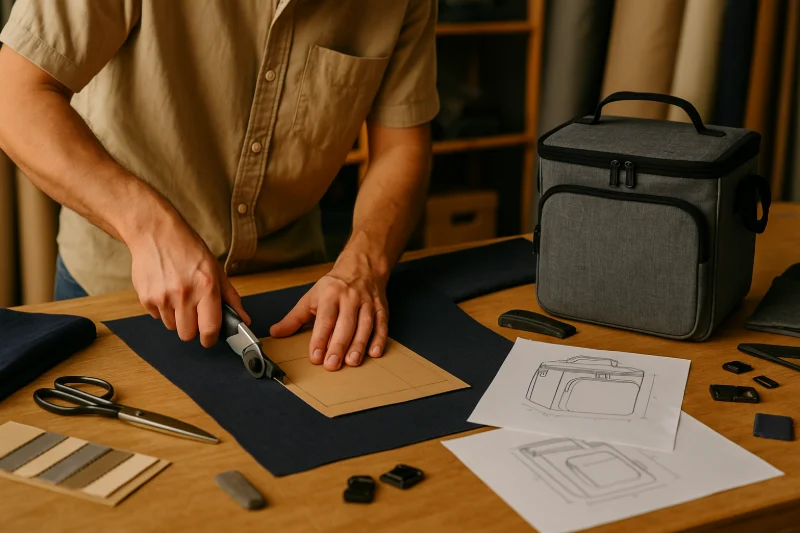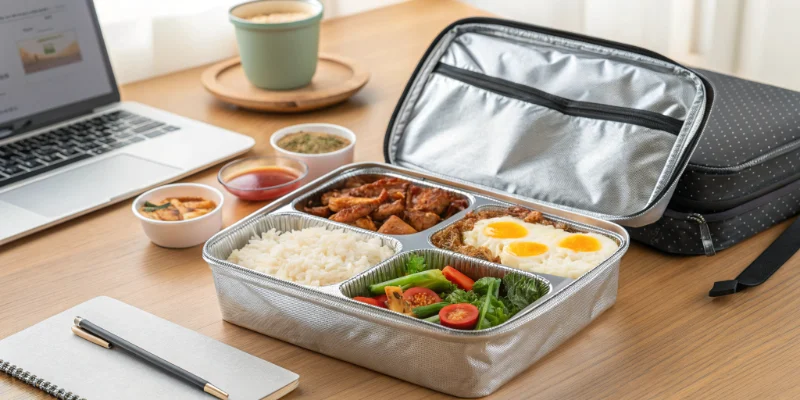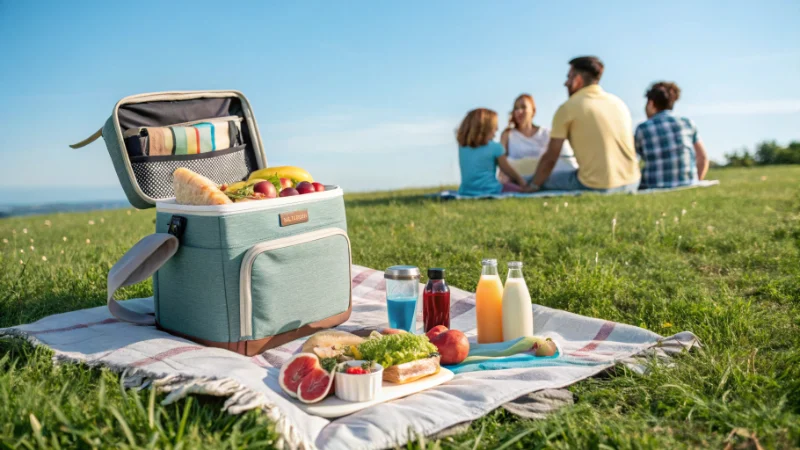Our Academy

Many people focus on the appearance when buying a cooler bag, without realizing that the real factors determining the user experience lie in the unseen details. Elements such as the thickness of the insulation layer, the bag’s structure, the comfort of the handle, and even the ease of cleaning—all of these small aspects can significantly affect usability, and choosing poorly often leads to frustration in daily use.
This is especially true for brand clients seeking customization. If material selection or printing methods are overlooked, it often results in a product that is costly to produce but lacks durability and premium quality. A truly practical cooler bag that also represents a brand’s image must stand the test of performance, appearance, and craftsmanship.
This article will take you through both the user and factory perspectives to fully understand the key factors to consider when customizing a cooler bag, helping you find the most suitable option—whether for personal use or bulk customization.
When choosing a cooler bag, several key factors directly affect its performance and longevity. The following sections explain these aspects in detail, including insulation quality, capacity design, material selection, portability, and ease of maintenance.
Soft cooler bags are generally made with a three-layer structure consisting of the outer fabric, an
EPE insulation layer1 and the inner lining. The inner lining is typically made of PEVA, PVC, or aluminum foil, each material offering distinct functional advantages.
PEVA and PVC linings are sewn together with the outer fabric and EPE insulation as separate layers. They provide excellent waterproofing and flexibility, effectively preventing condensation or beverage leakage inside the bag while being easy to clean. For products requiring higher waterproof performance, hot sealing treatment can be applied to the PEVA or PVC layer before stitching, further enhancing leak resistance. This type of structure generally has a thickness of 1.5–5 mm, offering around 4–8 hours of cooling performance, which can be extended up to 12 hours when used with ice packs—ideal for office, commuting, short trips, or daily meal use.
Aluminum foil linings, on the other hand, are directly laminated with the EPE foam layer to enhance reflective insulation. This design effectively reduces heat transfer and improves cooling efficiency. However, because the aluminum layer is thinner and sewn at the edges, frequent folding or long-term use may cause slight leakage along the seams.
In summary, for products intended for daily and repeated use, the EPE + PEVA/PVC inner structure is recommended for its waterproof, durable, and easy-to-clean properties. For short-term or cost-sensitive applications—such as commercial deliveries or promotional giveaways—the EPE + aluminum foil composite structure provides solid cooling performance at a lower production cost.

The capacity of a cooler bag is typically measured by how many beverage cans it can hold. Common specifications include 6–12 cans, 12–24 cans, 24–40 cans, and above 40 cans, each suited for different usage scenarios.
For personal or two-person use, a 6–12 can cooler bag is compact and lightweight—perfect for daily commuting or short trips. For family picnics or short weekend outings with three to four people, a 12–24 can medium-sized bag offers enough space for several meals and multiple drinks. For camping, group gatherings, or beverage delivery, a 24–40 can or
larger cooler bag2 is recommended; it provides longer cooling performance and can be paired with wheels or padded straps for easier transport.
During customization, the structure can also be adjusted based on usage. Cooler bags designed for beverages often feature a vertical layout to keep bottles upright, while those intended for food storage may use a wider base for flat placement of lunch boxes.
| Capacity (by can count) | Ideal Use | Key Features |
|---|---|---|
| 6–12 cans | Personal or two-person use, such as commuting or short trips | Lightweight and portable; suitable for small amounts of food or drinks |
| 12–24 cans | Family trips, picnics, or weekend gatherings | Moderate capacity, fits multiple meals and beverages |
| 24–40 cans | Camping, group activities, or outdoor leisure | Larger space, ideal for extended cooling or group use |
| 40+ cans | Commercial delivery, large events, or promotional purposes | Ample space for bulk storage and long-term cooling needs |
Common outer materials used for custom cooler bags include 600D polyester, Oxford fabric, Tyvek, washable kraft paper, non-woven fabric, laminated PP woven, and recycled RPET. Each material offers distinct advantages in durability, waterproof performance, and appearance. The following table provides a detailed comparison:

| Material | Durability | Water/Stain Resistance | Appearance | Cost Level | Common Uses |
|---|---|---|---|---|---|
| 600D Polyester / Oxford | High | Excellent | Practical, sturdy | Medium | Daily use, promotional giveaways |
| Tyvek | Medium | Excellent | Lightweight, unique texture | Medium-high | Eco gifts, brand customization |
| Washable Kraft Paper | Medium | Good | Natural, vintage look | Medium | Eco series or gift bags |
| Non-woven Fabric | Medium-low | Good | Lightweight | Low | Promotional events, bulk giveaways |
| PP Woven (Laminated) | High | Excellent | Smooth, structured | Medium | Everyday use, outdoor or commercial cooler bags |
| RPET (Laminated) | High | Excellent | Smooth, eco-friendly | Medium | Everyday use, sustainable brand projects |
| PVC / PEVA (Inner Lining) | Medium | Excellent | Smooth, easy to clean | Medium | Insulation lining, leak-proof structure |
| Aluminum Foil (Inner Lining) | Medium | Excellent | Metallic reflective surface | Low | Reflective insulation layer |
Common carrying structures for cooler bags include:
Hand-carry type
Shoulder-carry type
Wheeled type
| Carrying Style | Features | Ideal Scenarios |
|---|---|---|
| Hand-carry | Available in multiple sizes, from small to large; can be single- or double-handled | Versatile for all occasions—ideal for family use, picnics, or commercial delivery |
| Shoulder-carry | Usually smaller and lightweight; keeps hands free | Suitable for commuting, shopping, or carrying small quantities of food or drinks |
| Wheeled | Equipped with handles and wheels; easy to move for heavy loads | Perfect for group events, camping, or beverage transportation |
Inner lining materials: Choose PEVA or PVC for smooth surfaces that can be easily wiped clean with a damp cloth or tissue; resistant to odors and stains.
Seam construction: Use hot sealing at the lining seams to minimize needle holes and prevent leakage, making cleaning easier.
Opening design: Opt for large zipper openings or U-shaped designs to allow easy access and quick interior cleaning.
Outer fabric: Select stain-resistant, easy-wipe materials such as Oxford fabric, polyester, Tyvek, or laminated fabrics with a basic water-repellent coating for simple maintenance.
Accessory details: Removable hard bottoms or detachable inner pads make separate cleaning more convenient.
Cleaning and Maintenance Tips (For Daily Use)
Empty melted water promptly after use, and clean the inside with mild detergent and a soft cloth. Dry completely before closing to avoid odors.
Use ice packs instead of loose ice to minimize water residue.
Avoid strong acids, alkalis, chlorine-based bleach, and high-temperature drying. When storing for long periods, keep the zipper slightly open to allow ventilation and prevent odor buildup.
Different types of cooler bags vary in capacity, material, and usage scenarios. Choosing the right type ensures that both insulation performance and user experience align with actual needs. Below are several common types and their typical applications.

These cooler bags are generally small in size, focusing on lightness and practicality. They are ideal for office workers or students, typically holding between 6–12 cans. They can store lunch boxes, drinks, or small fruits. The insulation time is moderate, and they are easy to clean—perfect for daily, repeated use.
Picnic and outdoor cooler bags usually have a larger capacity. They use thicker insulation layers to extend cooling time and feature durable, water-resistant outer fabrics that perform well on grass, sand, or camping grounds. They are suitable for family outings or weekend camping trips.
Travel cooler bags emphasize portability and flexible storage. They often include adjustable shoulder straps or waterproof inner linings for easy cleaning. The mainstream structure combines Oxford fabric with PEVA lining, offering both waterproofing and lightweight performance. They are suitable for road trips or carrying meals and drinks during travel.
These cooler bags are mainly used for brand promotion or corporate giveaways. They focus on large printing areas and lightweight structures, allowing customization of colors, logo placement, and size according to brand style. Common capacities range from 6–24 cans, offering easy portability while meeting daily cooling needs.
When customizing cooler bags, several additional aspects determine the overall quality and value of the final product. These include functional features, printing methods, visual design, production quantity, and factory reliability.
The functional design of cooler bags can be adjusted flexibly based on industry requirements. Common customizable features include multiple pocket layouts, layered compartments, and adjustable shoulder straps3. These details play a major role in practicality and user experience.
The printing method determines how your brand appears on the cooler bag. Common techniques include screen printing, heat transfer, UV printing, digital printing, gravure printing, and embroidery. Each offers different advantages in terms of color depth, clarity, and cost.
In practice, clients don’t need to decide on the printing method themselves. Experienced manufacturers will recommend the most economical and suitable solution based on the bag’s material, design complexity, and order quantity—ensuring balance between color performance, durability, and production efficiency.
When customizing cooler bags, the visual focus is on brand identity presentation. Most clients choose to add company logos, brand names, contact information, or QR codes to enhance brand visibility in real-life usage. The printing can range from a simple single-color logo to a full-surface design, depending on the brand’s positioning and intended use.
There is a direct relationship between minimum order quantity (MOQ) and cost. Generally, larger orders benefit from lower unit prices, while small-batch production tends to be slightly higher in cost due to printing setup, material cutting, labor, and logistics allocation.
Selecting the right manufacturing partner is key to ensuring both quality and on-time delivery. A reliable factory typically offers:
Extensive production experience and technical expertise: Providing suitable recommendations based on materials and construction.
Sample confirmation process: Ensuring that dimensions, printing, and details match mass production.
Consistent lead time: Completing production plans on schedule and avoiding delays.
Efficient communication and service: Responding quickly to needs and assisting with production-related issues.
Manufacturers that meet these standards can consistently deliver reliable quality and ensure a smoother overall collaboration process.

When buying or customizing a cooler bag, multiple factors must be considered together, including insulation structure, outer materials, capacity design, portability, and cleaning convenience. These details collectively affect cooling performance, durability, and overall user experience.
For brand clients, defining the intended purpose and budget while communicating with an experienced manufacturer about materials, structure, and printing options helps achieve the right balance between visual design and functionality. Through systematic selection and sample confirmation, every cooler bag can combine quality with practicality—perfectly meeting market needs and brand positioning.
Whether you need a reliable cooler bag, a lightweight insulated tote, or a durable thermal lunch bag for branding or wholesale purposes, Yanxin Bag can provide the right solution.
As a professional manufacturer with years of experience, we specialize in producing custom insulated bags that combine strong insulation performance, practical design, and premium printing quality. Contact Yanxin Bag today to discuss your next custom cooler or insulated bag project — and discover how we can help you build products that truly represent your brand.
Not sure how insulation structure keeps your food fresh?
This article explains the multi-layered design of insulated lunch bags, including outer fabrics, interior linings, insulation cores, and zipper sealing. It helps clarify how each element plays a role in maintaining food temperature.
Want a full overview before designing your own cooler bag?
This article introduces the concept of custom cooler bags, compares soft and hard types, and outlines key customization options such as size, structure, materials, printing, and usage scenarios for various industries and audiences.
Unsure how to maintain your customized cooler bag?
This guide covers specific cleaning instructions for different materials used in cooler bags — including non-woven, polyester, cotton, laminated, and Tyvek types — and explains how to wash and dry them properly to extend usability.
Deciding between soft or hard cooler for your design?
This article compares soft and hard coolers by discussing their definitions, structures, insulation performance, capacity, portability, durability, and intended use scenarios, helping you choose the right base for customization.
Want to improve heat retention in your bag design?
This article explores factors that affect how long insulated bags keep food warm, including sealing methods, insulation structure, material types, bag size, and food packaging. It also shares tips to enhance thermal retention during use.
Get a free quote and expert consultation today. Let's bring your brand vision to life.
1 As noted by Wikipedia, EPE (Expanded Polyethylene) is commonly used as an insulation material in soft cooler bags due to its lightweight and closed-cell structure.
2 According to the U.S. Department of Agriculture (USDA), insulated cooler bags are designed to maintain safe food temperatures, and larger cooler bags can provide longer cooling performance when used properly with ice packs.
3 According to a peer-reviewed ergonomic study, wider and adjustable shoulder straps can significantly reduce shoulder pressure and improve carrying comfort, supporting their inclusion as a key feature in cooler bag design.
Answer: A cooler bag (also called an insulated bag or thermal tote) is a soft-sided, flexible container designed to keep food and drinks cool (or warm) for short to medium durations. It differs from a hard cooler in being more portable, lightweight, and often suitable for everyday use, whereas hard coolers use thicker rigid insulation and are optimized for longer hold times and heavier loads.
Answer: For daily lunch use the article recommends a cooler bag capacity of around 6–12 cans which is compact, lightweight and suitable for carrying a lunch box, a drink and small provisions. The right size helps keep your meals cold but still easy to carry.
Answer: Yes, most reusable cooler bags are made from durable materials like nonwoven fabric, canvas, or RPET, making them environmentally friendly alternatives to single-use plastic bags.
Answer: Durable outer fabrics include high-denier materials like 600D polyester, Oxford fabric, laminated PP woven, and RPET laminated fabrics. These materials combine abrasion resistance, water-resistance, and aesthetic quality suitable for custom branding.
Answer: Yes—while cooler bags are often used for cold items, many soft cooler bags or insulated bags are also designed to maintain warmth. The material structure (insulation layer + reflective lining + outer fabric) helps slow temperature transfer in either direction.
Answer: The article identifies three main carrying styles: hand-carry type, shoulder-carry type, and wheeled type. Each offers different portability: hand-carry is versatile; shoulder-carry frees your hands; wheeled helps with heavy loads or longer distances.
Answer: The best insulation materials for reusable insulated cooler bags include EPE foam combined with aluminum foil, PE foam with snowflake aluminum layers, and multi-layer designs with PEVA or PVC linings for enhanced waterproofing. These structures provide effective temperature control for both hot and cold storage.
Answer: To clean reusable cooler bags, wipe the inner lining with a damp cloth or mild detergent. PEVA and PVC linings are easy to maintain due to their waterproof surfaces. Avoid machine washing unless specified. Proper care extends the life of custom cooler bags and maintains their insulation performance.
Answer: Cooler bags can maintain temperature for a short time without ice packs, but for optimal insulation performance, using ice packs is strongly recommended.

Order or no-order we are Always here to help you!
We will contact you within 1 working day, please pay attention to the email with the suffix “@yanxinbag.com”.
Order or no-order we are Always here to help you!
We will contact you within 1 working day, please pay attention to the email with the suffix “@yanxinbag.com”.